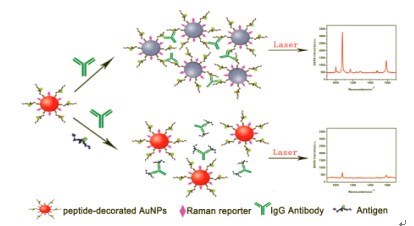

Surface-Enhanced Raman Scattering Based Biosensor for Histone Acetylation Detection
Received date: 2013-02-03
Online published: 2013-04-12
Supported by
Project supported by National Natural Science Foundation of China (Nos. 21025521, 21035001, 21190041, 21205034) and National Key Basic Research Program (No. 2011CB911000).
A new biosensing approach is developed for the detection of histone acetylation using a surface-enhanced Raman scattering (SERS) nanoprobe constructed by decorating gold nanoparticles (AuNPs) with acetylated histone H3 peptide and 4-MTP. Using absorption spectrum and dynamic light scattering analysis, we observe acteyl-histone antibody is able to mediate a network-like assembly of SERS nanoprobes, and strong plasmonic coupling between AuNPs is thus induced with a remarkably enhanced SERS signal. Based on this finding, we report the proof-of-principle of a competitive immunoassay biosensor for acetylated histone via the competitive interactions of acteyl-histone antibody with target antigen and SERS nanoprobe. In the absence of acetylated histone, the binding of acetylated H3 peptide to its antibody triggers the assembly of the SERS nanoprobes and thus induces a strong SERS signal. The presence of target antigen, which will competite for binding sites of the antibodies, disables the binding of acetylated H3 peptide to its antibody, prevents the assembly of the SERS nanoprobes and thus merely generate a weak SERS response. The results reveal that the developed biosensor has high sensitivity for detecting the acetylated histone. A linear correlation is obtained for the SERS signals to the logarithmic acetylated histone concentration ranging from 0.5 nmol·L-1 to 200 nmol·L-1 with a detection limit of 0.5 nmol·L-1. Additionally, the design of the biosensor allows a visual and homogeneous assay of the acetylated histone with no need of antibody labeling, which affords improved assay simplicity and throughput. This biosensor strategy may provide a convenient, rapid, highly sensitive and selective, homogeneous platform for histone acetylation assay. With the use of different Raman dyes and peptides, this biosensor might be further developed for multiplexed assays of different histone modifications.

Long Haoxu , Zhen Zhen , Tang Lijuan , Jiang Jianhui . Surface-Enhanced Raman Scattering Based Biosensor for Histone Acetylation Detection[J]. Acta Chimica Sinica, 2013 , 71(05) : 739 -742 . DOI: 10.6023/A13020171
/
| 〈 |
|
〉 |